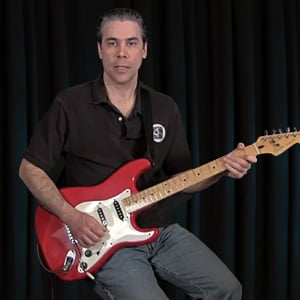Description
So now we've covered all the open string notes. We've also learned the letter names of the notes on the first five frets. We've seen how we use the letters A, B, C, D, E, F, and G to names those notes.
The letters A through G are called the Natural Notes.
Notice that in the melody "House of the Rising Sun" we used a note in between the notes A and G on the bottom E string.
The notes on the frets in between the Natural Notes are called Accidental Notes.
Accidental Notes are named by using a letter and a symbol. The symbol can be either a sharp, which is identified with a symbol that looks like a number symbols "#", or a flat, which is identified with a symbol that looks like a lower case "b".
Look at the image below to see how this looks in music notation.
An Accidental Notes is called a sharp note if it is one fret higher in pitch than it's Natural Named Note. Since the note G is on the third fret of the bottom E string, then the note one fret higher, on the fourth fret is called G-sharp (G#).
On the other hand, an Accidental Notes is called a flat note if it is one fret lower in pitch than it's Natural Named Note. Since the note A is on the fifth fret of the bottom E string, then the note one fret lower, on the fourth fret can also be called A-flat (Ab).
Whether we call a note sharp or flat depends on the musical context of the song being played. We'll get more in depth about that later. Right now, it's just important to know that the notes in between the Natural Notes are called Accidental Notes; sharps and flats. It is perfectly okay to call a G-sharp an A-flat or the other way around.
This idea of Natural and Accidental Notes leads to a system by which we can name any and all notes on the guitar. The only exceptions to the system are the notes B and C, and E and F. In between those notes there are NO Accidentals. They are right next to one another.
So, we wind up with a grand total of 12 possible notes on the guitar and in all music:
Then the whole things repeats again with A.
This idea can take a while to memorize. Take your time and be patient with yourself. The more you review this idea, gradually over time you can memorize the whole thing.
